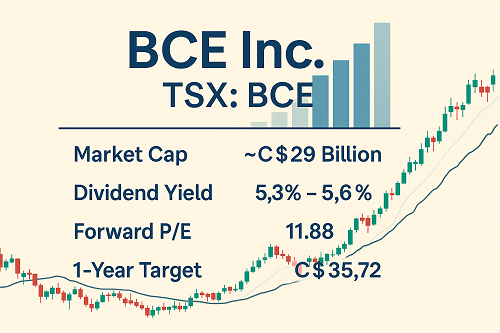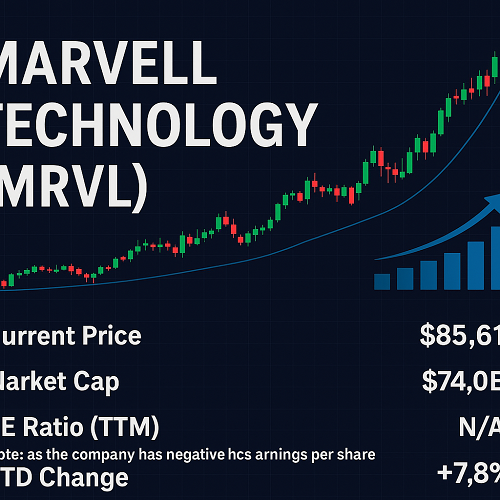BCE Inc. is Canada’s leading telecom and media company. For traders and investors, TSX: BCE presents a complex opportunity: stable dividend yield, slowing growth in legacy business, regulatory risk, and fiber-/5G-led growth potential. This article covers company background, financials, valuation, technicals, risks, and strategies (both long-term and short-term) — enabling you to understand the full picture and make informed decisions.
Company Profile & Business Overview
Company Background
- BCE Inc. (formerly Bell Canada Enterprises) is a major Canadian telecom & media holding company.
- Headquarters: Verdun, Quebec, Canada.
- Founded (in its current holding-company structure) via reorganization in 1983.
- Core businesses:
- Fixed-line and wireless telephony
- Internet (broadband / fibre)
- Television, radio & digital media (via Bell Media)
- Wholesale communications services
Business Segments & Strategic Focus
- The telecom business remains the backbone: Bell Mobility, Bell Fibe, broadband.
- The media segment (Bell Media) includes conventional TV networks (CTV, CTV2), specialty channels (RDS, TSN), radio stations and digital media.
- Strategic investments: fibre-optic network expansion, 5G roll-out, bundling of media/telecom services, cost-saving initiatives. For example, one recent plan aims for C$1.5 billion in cost savings by 2028.
Industry & Competitive Landscape
- Dominant player in Canada’s telecom space, but faces competition from other large players (e.g., Rogers Communications, Telus Corporation) and regulatory pressures (Canadian Radio-television and Telecommunications Commission – CRTC) regarding pricing and infrastructure.
- Telecom is largely a capital-intensive business: heavy network investment, high fixed costs, relatively stable but slow growth in mature markets.
Financial Performance & Metrics
Recent Financial Snapshot
- Revenue (latest full year): ~ CAD 24.41 billion.
- Net income (FY) ~ CAD 344 million (though margin is fairly thin relative to revenue).
- Market capitalization ≈ CAD $29-30 billion.
- Dividend yield (indicated): ~5.3-5.6%. E.g., one snapshot: “dividend yield (indicated) 5.57%”.
Valuation Ratios
- Price-to-Earnings (P/E) TTM: Very high in some data snapshots (≈67.09) reflecting depressed earnings.
- Forward P/E is better (≈11.88) per one snapshot.
- Price/Sales, EV/EBITDA and other advanced ratios are available via financial pages.
Growth & Profitability Trends
- Revenue growth: moderate to slow in Canada’s mature telecom market.
- Margin pressure: high network investment, competition, and regulatory burden weigh on earnings.
- Free cash flow: critical for dividend sustainability. Investors must monitor cash-flow trends carefully.
- One red flag: the large gap between revenue (~24 billion) and net income (~few hundred million) suggests heavy costs or amortization/interest burdens.
Dividend & Income Investors’ View
- BCE has a long history of paying dividends, making it a favorite among income-oriented Canadian investors.
- Yield ~5.3-5.6% as of late data. This suggests attractive income potential if dividend stability is maintained.
- But key risks: If earnings falter or free cash flow shrinks, dividend cuts become possible — something income investors must guard against.
Technical & Trading Analysis
Current Technical Status
- Based on data on TradingView for TSX:BCE: the “Technicals” gauge indicates a Sell signal today.
- 1-week and 1-month ratings both show a “sell” trend.
Price Forecasts & Analyst Insights
- Analyst 1-year price target: ~CAD 35.72 (≈+11.4% upside from recent levels) based on 16 analysts. Range: 30.00-43.00.
- These targets reflect expectations of stabilizing earnings and possibly improved growth from fibre/5G.
Seasonal Patterns
- The “Seasonals” chart tool shows repeating trends over previous years; for BCE the data suggest certain times of year might offer better entry points.
- Important for shorter-term traders to exploit seasonal tendencies.
Key Technical Levels & Patterns (for short-term traders)
- Support zones: Historically, in the CAD 28-33 range in recent downturns.
- Resistance zones: Around CAD 40 (recent highs) according to 52-week range.
- Chart patterns: Traders have discussed possible inverse head & shoulders, double bottom setups on BCE.
- Moving averages: Use 50- and 200-day MAs to monitor trend direction and potential reversal points.
SWOT Analysis
Strengths
- Leading market position in a stable sector (telecom + media).
- Significant dividend yield, which appeals to income investors.
- Large scale, diversified services (mobile, broadband, media) offering some protection through diversification.
- Strategic focus on fibre and next-gen infrastructure gives growth levers.
Weaknesses
- Slowing growth in mature Canadian market — limited domestic expansion.
- Regulatory risk (rate caps, pricing pressure, infrastructure mandates).
- Large capital expenditure requirements / heavy debt or amortization can strain margins.
- The valuation metrics suggest current earnings do not justify the price for some investors.
Opportunities
- Fibre roll-out, 5G expansion, bundling of services may drive higher ARPU (average revenue per user) and margin expansion.
- Media streaming growth and cross-platform media/telecom bundling.
- Cost-saving initiatives (e.g., C$1.5 billion target by 2028) may improve free cash flow.
- Potential strategic acquisitions or partnerships (e.g., in adjacent digital services).
Threats
- Regulatory intervention (CRTC) reducing telecom pricing or limiting bundling.
- Disruption from OTT (over-the-top) media/streaming services or new competitors.
- Economic downturn / recession reducing consumer spending on telecom/media.
- Dividend cut risk if earnings or free cash flow deteriorate significantly.
Investment & Trading Strategy
Long-Term Investor View (3-5 years)
- Consider BCE for dividend income, if you believe in the infrastructure value and the company’s ability to maintain / grow free cash flow.
- Entry strategy: Wait for a pull-back or improved earnings momentum before committing heavily.
- Monitor key indicators: free cash flow trends, fibre rollout progress, regulatory decisions, dividend stability.
- Exit strategy: Be ready to revisit the position if dividend yield falls, or cost structure deteriorates.
Short-Term Trader / Swing Strategy
- Use technical signals: breakouts above resistance or breakdowns below support.
- Consider seasonal patterns: support may show up at historically strong months.
- Watch technical indicators: RSI oversold/overbought, MACD crossovers, volume spikes.
- Example setup: If BCE forms inverted head & shoulders near CAD 30-32, with strong volume breakout above CAD 34-35, short term upside target could be CAD 38-40.
Risk Management
- Use stop-loss orders: for short-term trades, perhaps 5-10% below entry.
- For long-term holders: ensure position sizing such that a dividend cut or regulatory shock does not severely harm your portfolio.
- Beware of sector-specific risk: telecom/media often moves together; treat BCE within the context of the broader industry.
Valuation & Decision Framework
When evaluating BCE you should ask:
- Is the current dividend sustainable? Review free cash flow, debt, capex.
- What is the growth path? Fibre/5G-rollout, media bundling, ARPU improvement.
- What does the valuation imply? Forward P/E ~11.9 in one snapshot suggests upside if growth materializes.
- What are the risks? Regulatory, competitive, macro-economy.
- What is the trade vs hold scenario? If using for income, you may hold; if trading for growth or turnaround, you may aim for price appreciation.
Key Metrics at a Glance
| Metric | Value* |
|---|---|
| Revenue | ~ CAD 24.41 billion |
| Net Income | ~ CAD 344 million |
| Dividend Yield | ≈ 5.3-5.6% |
| Market Cap | ~ CAD 29-30 billion |
| Forward P/E | ~ 11.88 (one estimate) |
| 1-Year Price Target | CAD 35.72 (≈+11% upside) |
* As of latest publicly available data; subject to change.
Recent Developments & What to Watch
- BCE recently boosted its cost-saving target to C$1.5 billion by 2028.
- Analyst commentary suggests BCE is positioning itself in Canada’s “sovereign AI initiatives” via partnerships (e.g., with Cohere Inc.) – which could provide incremental upside.
- Upcoming earnings calls will be key: investors should look for growth signs in fibre broadband, upgrades to higher ARPU services, stability or modest growth in wireless, and margin expansion.
- Regulatory updates: any changes in CRTC policy or telecom pricing regulation could materially impact BCE’s outlook.
Risks & Red Flags to Monitor
- Dividend risk: If free cash flow shrinks, a dividend cut is not impossible.
- Competitive pressure: New entrants or shifts to OTT media or low-cost mobile plans could erode margins.
- Capital intensity: Large capex outlays for fibre and 5G must produce returns.
- Regulatory / political risk: Telecom is a regulated sector; changes in spectrum licensing, pricing caps, or media regulation could hurt.
- Macro-economic: A severe Canadian recession could reduce consumer spending on premium bundles.
Conclusion – Is BCE a Buy, Hold, or Sell?
Buy: If you believe BCE can deliver steady free cash flow growth via fibre and 5G, maintain its dividend, and if you are comfortable with moderate upside (~10-20%) plus yield.
Hold: If you already own BCE for the dividend and are comfortable with slower growth but steady income.
Sell or Avoid: If you expect growth to stagnate, regulatory risk to bite, or prefer higher-growth stocks rather than telecoms with slower expansion.





 XAUT-USD
XAUT-USD  AMD
AMD  MARA
MARA  SHOP
SHOP  BULL
BULL  CL=F
CL=F